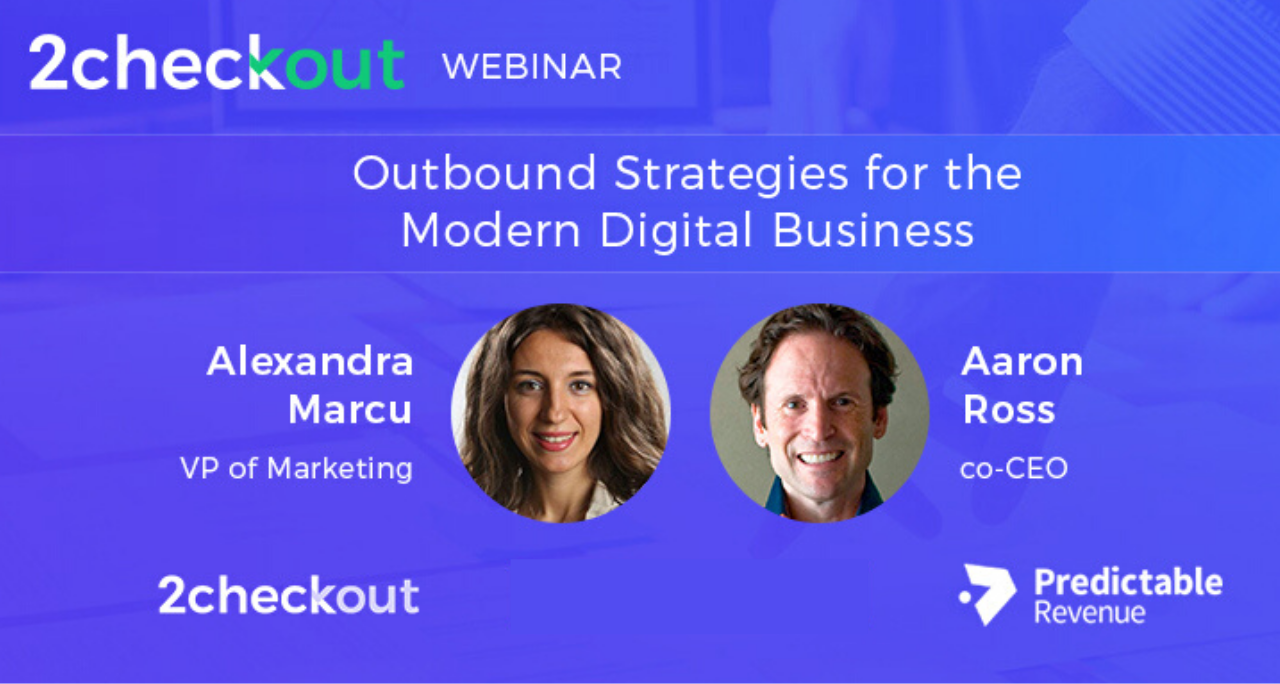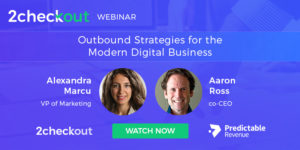It’s fair to say that Aaron Ross, Co-CEO of Predictable Revenue Inc., understands outbound inside and out: he has written best-selling books based on the outbound systems he and his team created for Salesforce.com and other companies, which have created billions in value.
Aaron recently presented a webinar, hosted by 2Checkout, titled “How to Combine Marketing and Onboard Skills to Drive Leads.”
“Outbound is for everyone; it’s a life skill, and can be used by almost any company,” Aaron said. “It doesn’t mean you should do it, but it’s an option to look at. It might be outside your comfort zone, but one of the advantages of COVID-19 situation is that it has forced businesses out of their comfort zones.”
He kicked off his presentation with an overview of the three main types of leads (including outbound), known as “seeds,” “nets,” and “spears.”
- Seeds, he explained, are the traditional type of leads that are driven by word-of-mouth;
- Nets are marketing-driven leads (things like PPC, webinars, billboards);
- Spears are outbound prospecting/business development, with a targeted list of customers to whom you reach out via LinkedIn, email, phone, Instagram, WhatsApp. Spears, or outbound, might be summed up by “cold-calling.”
“All three types of leads have different funnels, metrics, and deal sizes,” Aaron emphasized. “Each of them also has its pros and cons.”
Seeds/word-of-mouth have the highest buy cycles and close rates, and are easy to deal with, Aaron points out; their downside is that they can be really hard to grow, while nets/marketing-driven leads are typically quantity over quality.
Spears/outbound prospecting development are great because you can talk directly to your customers or partners and typically create bigger deal or opportunity sizes, but this is not for every company, and only really works with larger opportunities. Bottom line: “You can’t make money through outbound with $50 opportunities, unless you have enough channel partners,” Aaron said.
The basic outbound prospecting routine for any type of business is quite simple, and has five main components that Aaron shared in his presentation:
- Identify your ideal customer profile: Identify those with highest revenue and potential and highest close rates
- Build your list of targets: Import into sales/marketing systems
- Run email campaigns to make first contacts: Generate internal referrals
- Sell the dream: Connect the targets’ needs to the solution(s) you offer
- Pass the baton: Hand off to a salesperson so they can bring them on as customers.
Aaron shared a typical cold-calling funnel example: you prepare your database of targets, then make contact with your prospects, then, finally, you begin the sales cycle. He went on to emphasize that lead generation is what really helps drive growth; if you have an erratic source of leads, you may struggle.
Aaron pointed that outbound and marketing can go hand in hand, but quality over quantity should be the priority. “One of the keys to outbound is forcing yourself to think about who your ideal targets are—[aim for] fewer, bigger, better opportunities, speaking engagements, distribution partners, and customers,” he says.
Following up on Aaron’s presentation, we used our own experience with outbound at 2Checkout, exemplifying Aaron’s insightful tactics.
We introduced the top areas that presented challenges during 2Checkout’s outbound journey, and are critical for other businesses to address as they adopt outbound:
- Setting up the target criteria—identifying the perfect client; buyer roles and profiles; and optimal criteria for sales team to engage.
- Alignment with sales—defining shared objectives; roles allocation and processes; mutually agreed upon target profiles and engagement criteria; weekly sync meetings; sharing what has worked and what hasn’t.
- Accounts handover—defining when to engage how to allocate accounts; what alerts to send, etc.; what will be the next steps for sales; and recycling criteria.
- Outreach plans—planning the exact workflow by target profile (first cold call, first email campaign, etc.); flexible scripts; outreach plans optimization; and personalization.
- Lead-selling vs. account-based selling—setting up personalized account playbooks; the right framework; test, optimize, and repeat; social selling; respecting privacy rules.
- Account-based marketing—aiming for micro-targeting; highly personalized and high-touch marketing efforts; account based advertising (although expensive); social selling, but wisely chosen channels.
- Expectations—expecting different funnel conversion rates and length; avoid unrealistic targets and quotas; don’t underestimate costs.
- The right tools and reports—consider carefully the tools you use and how you use them to create the most useful kinds of reports.
To view the entire webinar on combining marketing with outbound, visit this link.






